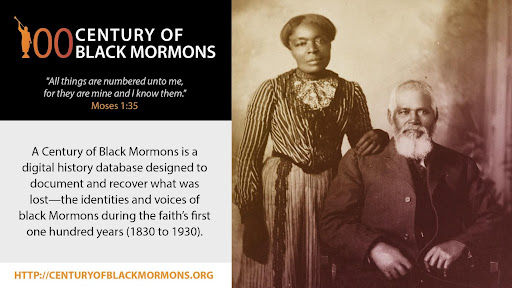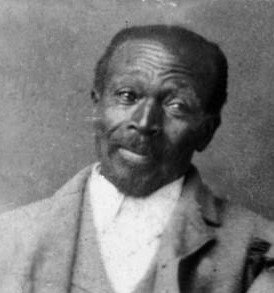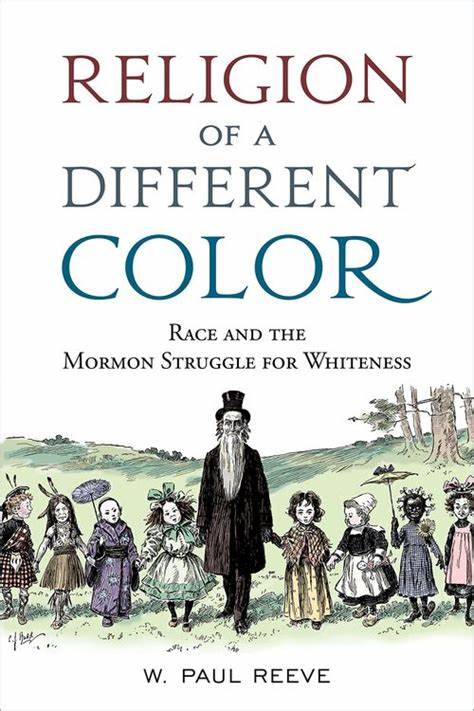Date: November 25, 2019 (Season 1, Episode 3 – Part 1: 23 min. & 44 seconds and Part 2: 21 min. & 23 seconds). Click here for Part 1 and Click here for Part 2 of the BuzzSprout version of this Speak Your Piece episode. Are you interested in other episodes of Speak Your Piece? Click Here. The above image is a photograph of Samuel and Amanda Chambers, a 19th Century Utah Mormon couple. Image courtesy of CenturyofBlackMormons.org. This episode was co-produced by Brad Westwood and Chelsey Zamir, with help (sound engineering and post-production editing) from Conner Sorenson of Studio Underground.
This SYP episode is an interview with W. Paul Reeve, University of Utah professor of history, with SYP host Brad Westwood about his public history project, Century of Black Mormons database, hosted by the J. Willard Marriott Library at the University of Utah, where he serves as the site’s general editor. In this database, Reeve highlights the Mormon African American experience in Utah from 1830-1930, which brings to light the stories of people that have been largely erased from public memory. The project aims to recover those stories and to ensure they will not be forgotten. Reeve also discusses his 2015 award-winning book Religion of a Different Color: Race and the Mormon Struggle for Whiteness (Oxford University Press), recognized by Brigham Young University as a tour-de-force, which traces the trajectory of the racial lens that Mormons have historically been seen through: from not white enough in the 19th century to too white in the 21st century.
Podcast Content:
Part One of Two:
Part Two of Two:
Why is the Century of Black Mormons database so important to Utah history? Reeve states that, at heart, he’s a social historian and thus attempts to understand history from the bottom up, as opposed to the top down – a perspective that allows for historians, such as himself, to understand the average person and, too often, those written off the historical narratives. Reeve also adds that he wanted a digital public history project that would engage the public in a different way and allow access to sources, names, numbers, and the identities of people of Black-African descent baptized into the Church of Jesus Christ of Latter-Day Saints (hereafter LDS Church) between 1830-1930.

Caption: Description of Reeve’s database.
Reeve touches on what primary source materials are and how they fit into this project. Primary sources are materials created during the time period in question, in other words, they are written records from people at the time of the event. Reeve and team use primary sources to uncover the stories of those on the margins of society, and in using these vital primary source records such as birth certificates, death certificates, and materials written by the person themself, this helps to paint a rich biographical picture of a person and/or event. Secondary sources, on the other hand, are materials that are written after the fact by someone else. Both are valuable source materials and serve their own purposes in conducting research to understand the full story.
What are the stories that this database provides to the public? The primary goal of this database is to provide the stories of the Mormon African American experience in Utah and to show that African Americans are a part of the LDS pioneer story. One of the first markers is in 1847 when a party of LDS pioneers came to the Salt Lake Valley and brought with them three enslaved men: Green Flake, Oscar (Crosby) Smith, and Hark (Lay) Wales. Both Flake and Smith were members of the LDS Church, and once settled in Utah, they were both re-baptized, a typical practice for those who arrived in the valley to demonstrate their commitment to their faith and an act of “rebirth” in their new location. Jane Elizabeth Manning James, another widely known African American Mormon, also arrived with her family into the Salt Lake Valley that same year.
Caption: Green Flake, an African American Mormon mentioned in this episode. Folklore says he drove Brigham Young’s wagon into Salt Lake Valley in 1847. Photograph courtesy of Peoples of Utah Photograph Collection, Utah State Historical Society.

1847 was an important marker of one of the first documented dates of Mormon African American’s arrival to the Utah territory, but there are other important, albeit unfortunate, dates for African American Mormons in the territory as well. In 1852, Brigham Young (second president of the LDS Church) articulated a race-based priesthood restriction to the Utah Territorial Legislature as they debated a servant code that defined the legal relationship between those who are enslaved and their enslavers. They passed an act in relation to service which defined the relationship as one of gradual emancipation: current slaves would not be freed but succeeding generations wouldn’t be held in slavery. This meant that those currently enslaved would die as slaves. In 1879, temple restrictions were enacted on Mormon African American within the faith. In 1908, Young stated although African Americans were welcome to convert to the LDS Church, missionaries would no longer seek out African Americans for conversion.
These racial-based restrictions were unfortunately reinforced and held sacrosanct until 1978, when the then LDS Church president Spencer W. Kimball offered an official decree ending, for the Salt Lake based church, its racially discriminating policy; essentially returning the church to its universalistic roots, bringing the faith back to where it had started in the 1830s-1840s. Learn more about this in Part 2 of this episode.
Reeve and Westwood conclude Part 1 of this episode in discussing why this project is of value today with such a large community of African Americans as current members of the LDS Church. Reeve states that there are approximately one million people in the faith who are of Black-African descent. It matters, Reeve continues, to give people a pioneer past they may not have been aware of. It demonstrates that they didn’t show up to this faith only after 1978, even though sometimes that’s how it has been portrayed. This is only because it’s too uncomfortable to speak about Mormon African Americans prior to 1978, as that would mean recognizing the racism that barred them from certain rituals within the faith. The database seeks to address those issues and allow the lives of those African Americans named in the site to speak their own stories.
In Part 2 of this episode, Reeve begins by telling listeners of SYP about some surprises he discovered while working on the Century of Black Mormons database. The database, Reeve notes, pinpoints locations of baptisms of African Americans. One interesting thing that emerged was a significant number of baptisms that took place in Utah. Reeve states his surprise in finding in the source materials documentation of 2nd, 3rd, 4th, and even 5th generations of African American LDS Church members, and not just pioneer converts to the faith, but that the faith has been passed on for generations.
The database paints the picture of a multi-generational nature of the faith with many baptisms of those generations having occurred in Utah. Reeve also adds that it isn’t just Mormon African American that played an important role in Utah. He states that, of course, there are Black migrants to Utah that also played very important roles in the state – some of the stories are mentioned in Salt Lake West Side Stories (a history of one SLC neighborhood) see “African Americans and Salt Lake’s West Side Part 1 and Part 2” – but Reeve adds that this database strictly covers African Americans within the faith and those that had faith transitions, for instance from those that were members of the LDS Church but left to join other faiths.


Caption: Ned Leggroan (left) and Alice Leggroan (right) are two African American Mormons listed in CenturyofBlackMormons.org highlighted by Reeve in Part 2 of this episode. The married couple were enslaved in the south prior to the Civil War. After the war, in 1870, the couple, now freed, migrated to Utah with their relative, Samuel Chambers, who had converted to the LDS Church after he became a freed man. By 1873, both Ned and Susan had also converted to Mormonism and were one such couple that presided over a multi-generational African American Mormon family. Photograph of Alice Leggroan courtesy of Alice Lawrence Williams, cropped photograph of Ned Leggroan courtesy of Joyce Leggroan Bridgewaters, both accessed on CenturyofBlackMormons.org.
Reeve’s other works on race include his 2015 award-winning book Religion of a Different Color: Race and the Mormon Struggle for Whiteness (Oxford University Press). Reeve notes that the thesis of this book is to address how Mormons, historically, have been seen through a racial lens. Starting in the nineteenth century, Reeve continues, Mormons were deemed as not “white” enough. This determination was largely based on Mormon policies of isolation and polygamy. At this time, members of the scientific and medical communities argued that the Mormon practice of polygamy contributed to the creation of a “denigrated” and “deformed” race and eventual sterility. In 1879, under the Hayes administration, the U.S. Government even went so far as to attempt to cut off European immigration to Utah, as large populations at the time were immigrating to Utah to convert to Mormonism. These immigrants, combined with the integration and conversion of Native American communities, contributed to “race mixing.” All of these policies and tactics contributed to the Mormon’s reputation as a suspect racial group, a real problem.
In response, Mormons, in general, attempted to claim “whiteness” for themselves by enacting policies of racial restrictions on membership to its male-based priesthood and restricting black members from receiving the highest ordinances in the church’s temples. However, by the twenty-first century, Reeve notes that racial roles reversed, and the Mormons had then become “too white.” From “not white enough,” to “too white,” the Mormons had to, yet again, respond and did so by attempting to claim an internationally and ethnically diverse racial identity for themselves.

Caption: Book cover for Reeve’s 2015 book Religion of a Different Color: Race and the Mormon Struggle for Whiteness. The picture on the cover is a political cartoon labeled as, “Elder Berry Mormon Elder Berry – out with his six-year-olds, who take after their mothers.”
Reeve concludes Part 2 of this episode in stating that one can’t really understand the present without understanding the past. While still unforgivable, in understanding the racial history of the Mormons, it helps us to make sense of the attempts by the Mormons to impose racial restrictions within church practices. Understanding this past will hopefully teach us some very valuable lessons and that, as Reeve puts it, “If you can racialize a group of largely white LDS [church members] as somehow not ‘white,’ it should help us understand that race is what we make up in our mind. It’s not a biological reality. It’s just simply what we’ll use to create a hierarchy to disadvantage some groups. You create them as an ‘other,’ suggesting that you were there for justified and discriminatory policies against them.” By doing so, large parts of history have been erased from public knowledge. Reeve hopes that his project is an attempt at bringing that history, and the stories of those silenced, back to public knowledge.
If you can racialize a group of largely white LDS [church members] as somehow not “white,” it should help us understand that race is what we make up in our mind. It’s not a biological reality. It’s just simply what we’ll use to create a hierarchy to disadvantage some groups. You create them as an “other,” suggesting that you were there for justified and discriminatory policies against them.
2023 post-script for the 2019 reissued episode: after this interview was conducted a concurrent project started at Brigham Young University that aligns with the Century of Black Mormons project. Once listeners have finished this episode, we encourage you to also check out that project: BYU Slavery Project – Studying the links between slavery and the founding of Brigham Young University. We also suggest reading further about BYU’s Slavery Project from this 2023 KUER news article The BYU Slavery Project is putting a historian’s eye on a darker past | KUER. If you’re interested in other African American history, we suggest this episode of Speak Your Piece “The New Juneteenth Holiday & Utah’s Laws on Interracial Marriage (1888-1963).”
Bio: W. Paul Reeve was raised in Hurricane (Washington County) Utah. Since 2008, Reeve has been professor of American, Western, Mormon and Utah history at the University of Utah. Reeve is the first-ever Simmons Professor of Mormon Studies at the University of Utah, and has written a number of books, including: Making Space on the Western Frontier: Mormons, Miners, and Southern Paiutes (2007), Between Pulpit and Pew: The Supernatural World in Mormon History and Folklore (with Michael Scott Van Wagenen, 2011), and Religion of a Different Color: Race and the Mormon Struggle for Whiteness (2015).

Additional Resources & Readings:
- Reeve, W. Paul and Ardis E. Parshall, eds. Mormonism: A Historical Encyclopedia. Santa Barbara, California: ABC-CLIO, 2010.
- Additional reading on African American history: BYU’s Slavery Project.
- Harris, Martha. “The BYU Slavery Project is putting a historian’s eye on a darker past.” KUER, January 12, 2023.
- For further listening on African American history, please listen to this episode of Speak Your Piece “The New Juneteenth Holiday & Utah’s Laws on Interracial Marriage (1888-1963).”
Do you have a question or comment, or a proposed guest for “Speak Your Piece?” Write us at “ask a historian” – askahistorian@utah.gov

